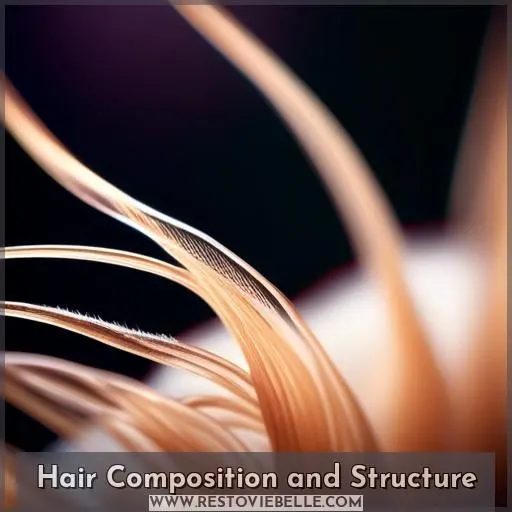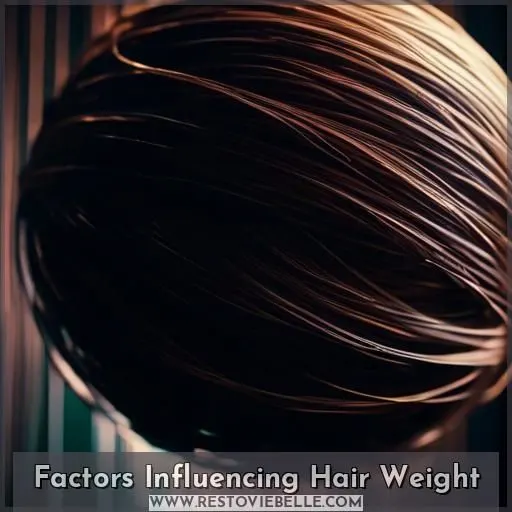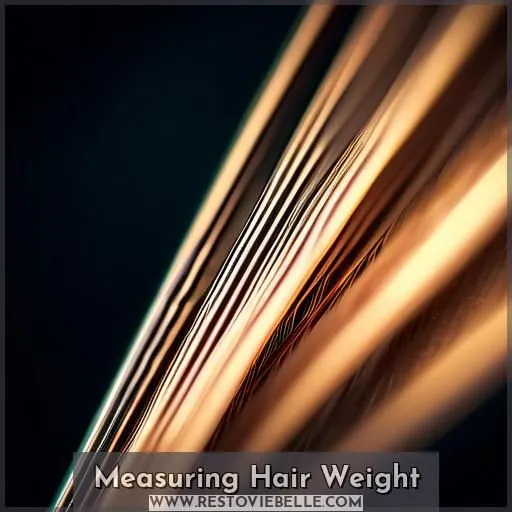This site is supported by our readers. We may earn a commission, at no cost to you, if you purchase through links.
 Your hair’s weight may fluctuate notably, but a typical 6-inch strand weighs around 0.000076-0.00013 ounces. Longer, thicker, and curlier hair strands generally weigh more than shorter, finer, and straighter ones.
Your hair’s weight may fluctuate notably, but a typical 6-inch strand weighs around 0.000076-0.00013 ounces. Longer, thicker, and curlier hair strands generally weigh more than shorter, finer, and straighter ones.
The weight of your hair is primarily determined by its keratin structure, hair type, length, and density. External factors like humidity can also slightly influence hair weight.
To maintain healthy, lustrous locks, focus on a balanced diet, proper hair care routine, and guarding your hair from damage. Continue reading to uncover the intriguing science behind how much your hair actually weighs.
Table Of Contents
Key Takeaways
- Hair weight is determined by its keratin structure, hair type, length, and density.
- External factors like humidity can also influence hair weight.
- To maintain healthy hair, focus on a balanced diet, proper hair care routine, and protecting hair from damage.
- Hair weight varies based on factors like hair type, length, and density.
How Much Does Hair Weigh?
On average, a single strand of hair typically weighs between 0.000015 ounces or about 0.0004 grams. The weight of hair can vary markedly depending on factors such as length, thickness, and the type of hair. On average, a person has about 100,000 to 150,000 hair follicles on their scalp, and the combined weight of all the hair can range from 2 to 5 ounces (56 to 142 grams).
Hair Composition and Structure
Your hair’s weight is fundamentally tied to its composition and structure. The primary component, keratin, forms a strong yet flexible matrix through intricate disulfide bonds, contributing to the strength and resilience of each individual strand.
Role of Keratin
Your hair’s weight is an indication of its keratin structure.
Keratin molecules create disulfide bonds, giving strength and flexibility.
The arrangement of these bonds contributes to your hair’s strength and flexibility, which in turn affects its ability to absorb water and maintain its weight.
As a protein-based material, hair chemistry plays a key role in determining its weight, with variations in keratin density impacting weight distribution.
Understanding these factors is essential for accurately measuring hair weight and keeping it healthy.
Hair Strand Anatomy
Explore the intricate structure of your hair strands, as we navigate the realm of hair strand anatomy.
Each strand is primarily composed of keratin protein, with keratin molecules forming disulfide bonds for strength and structure.
The arrangement of these bonds contributes to hair flexibility.
Factors like hair length, density, coarseness, hydration, and growth phase all play a role in your hair’s overall weight and characteristics.
Strength and Flexibility Factors
Delving deeper into hair composition, we find that the strength and flexibility of luscious locks can be attributed to the arrangement of keratin molecules.
These molecules form disulfide bonds, which contribute to the overall structure and strength of hair.
The keratin density also plays a vital role, as it affects weight distribution and the pliability of hair.
So, the next time you’re wondering ‘how much does hair weigh?’ or considering a haircut, remember that these factors are at play, shaping locks into the masterpiece they are.
Factors Influencing Hair Weight
Your hair’s weight isn’t a fixed value; it varies based on several factors.
The type of hair you have—whether straight, wavy, curly, or kinky—affects its overall thickness and density, influencing the weight.
Additionally, longer hair strands weigh more than shorter ones.
Hair density (the number of follicles per square inch) contributes notably to the total weight.
The dynamics of growth and shedding can cause fluctuations in hair weight over time.
Hair Type Variations
Your hair’s weight isn’t just about length.
Hair type variations, like texture, porosity, thickness, volume, and density, also play a significant role.
For instance, curly hair tends to be denser and heavier than straight hair.
A 6-inch long piece of curly hair can weigh up to 0.00013 ounces, while straight hair might only weigh 0.000076 ounces.
Understanding these factors can help you appreciate the unique weight of your own luscious locks.
Impact of Hair Length
After delving into the realm of hair classifications, let’s confront the primary concern: hair length. It resembles hair weightlifting; extended strands signify a greater burden.
- Extended hair heightens the visibility of hair loss.
- Hair extensions augment volume and length instantaneously.
- Enhanced length can strain hair thickness.
- In essence, extended hair equates to a weightier headpiece.
Hair Density and Its Effects
Hair density, also known as hair follicles per square inch, differs among individuals.
This can have a noticeable impact on hair weight.
A greater density indicates more hair follicles, resulting in heavier hair.
Factors like hair thickness, texture, and porosity can also affect hair density.
These factors influence the overall weight of the hair.
Appropriate hair care practices are essential for maintaining a healthy hair density and weight.
Preventing excessive breakage is crucial for maintaining hair density and weight.
Growth and Shedding Dynamics
Hair growth and shedding dynamics play a significant role in hair weight. The average growth rate is 0.5 inches per month, with annual growth reaching 6 inches. Shedding occurs daily, with 50-100 strands lost. Density variations impact styling and management. Growth rate, shedding patterns, and density can all influence hair health and hygiene practices.
Measuring Hair Weight
You might be surprised to learn that accurately measuring hair weight is more complex than it appears. Obtaining a representative sample, adjusting for moisture content, and utilizing specialized weighing techniques are essential steps to guarantee precise results.
Techniques for Accurate Measurement
To accurately measure hair weight, use specialized hair scales.
Collect a representative sample, ensuring it’s clean, dry, and free of products.
Adjust for hair moisture and type, as well as density.
Consider sample size and hair length. For instance, a 6-inch long piece of hair weighs 0.000076 to 0.00013 ounces.
Importance of Sample Representation
To precisely assess the mass of your hair, it’s imperative to establish a representative sample. Here are some key factors to bear in mind:
- Sample Volume: The extent of the sample you gather will influence the precision of your measurement. A larger sample volume generally provides a more representative and dependable outcome.
- Precision: Strive for a sample that closely approximates the average hair mass. This can be achieved by collecting hair from diverse regions of the scalp, ensuring a balanced representation of hair textures and lengths.
- Prejudice: Be cognizant of potential biases that could skew your results. For example, if you only gather hair from one area of the scalp, you may not capture the full spectrum of hair textures and lengths, leading to an inaccurate measurement.
- Dissimilarity: Hair mass can vary considerably between individuals, so it’s essential to take into account the natural variation in hair mass when interpreting your results.
- Reiteration: To ensure the reliability of your measurement, it’s imperative to replicate the process multiple times and compare the results. This can help you identify any inconsistencies or errors in your methodology.
Adjusting for Moisture and Cleanliness
When measuring your hair’s weight, don’t let moisture throw you off balance.
Wet locks can tip the scales, so always aim for bone-dry strands before you weigh in.
Cleanliness also plays its part; product buildup can add unwanted grams.
Imagine your hair as a feather-light entity, where every drop of water or dab of conditioner can tip the scales of truth.
Hair Weight Across Different Conditions
Your luscious locks undergo weight fluctuations across different conditions. Wet hair weighs more than dry hair due to the added weight of trapped water droplets; certain hair treatments like keratin straightening or coloring can temporarily increase hair weight; environmental factors like humidity can also affect your hair’s weight marginally.
Wet Vs. Dry Weight Differences
Regarding hair weight, the distinction between wet and dry states is subtle yet meaningful.
Wet hair carries more weight due to water absorption between strands, which can affect styling and product application.
Nonetheless, the weight discrepancy is usually modest and improbable to be noticeable.
Drying hair might reduce weight but could also cause damage.
So, take into account the moisture level and hair nature when contemplating your hair’s weight.
Changes With Hair Treatments
Hair treatments, like chemical treatments, coloring, and extensions, can noticeably affect the weight of your hair. Here are three essential factors to keep in mind:
- Chemical Treatments: Chemical treatments such as relaxers and perm solutions can alter the makeup of your hair, potentially impacting its weight. Some treatments may make hair lighter or thinner, while others may make it denser or heavier.
- Hair Color: Hair coloring can also influence hair weight. Different coloring techniques, like bleaching or highlighting, can change the texture and density of your hair, causing changes in weight.
- Hair Extensions: The weight of hair extensions depends on their thickness and length. For example, a 50-gram hair extension set can provide a small thickness boost, while a 100-gram set can provide a half head of extensions for medium to fine hair.
These factors should be considered when thinking about the overall weight of your hair.
Effect of Environmental Factors
Environmental elements such as pollution, humidity, sun exposure, and hair care products can noticeably influence the substance of your hair.
Pollution and potent chemicals can burden your hair.
Humidity can lead it to absorb water, magnifying its weight.
Sun exposure can dehydrate your hair, causing it to become less substantial.
Styling products can add weight to your hair, affecting its overall look.
Comprehending these elements can assist you in maintaining healthy hair and adapting your styling practices accordingly.
Managing and Maintaining Hair Health
To maintain healthy and luscious locks, you must prioritize a balanced diet rich in proteins, vitamins, and minerals, as well as adopt a consistent hair care routine. Consulting a professional stylist can provide personalized guidance on the most suitable products and techniques to nourish your hair and address any specific concerns or issues you may have.
Role of Diet and Lifestyle
Your hair’s health is influenced by a combination of genetics and lifestyle factors. Here are three ways to boost your hair health:
- Balanced Diet: Include protein-rich foods like eggs, fish, and legumes to support hair growth.
- Hydration: Drink plenty of water and limit caffeine and alcohol to maintain hair hydration.
- Stress Management: Practice mindfulness, exercise, and get enough sleep to reduce stress, which can negatively impact hair health.
Recommended Care Practices
To maintain the health of your hair, it’s essential to practice proper care.
This includes regular washing and conditioning.
Avoiding excessive heat styling is also important.
Protecting your hair from environmental factors like the sun is necessary.
Using detangling tools, styling products, hair masks, and hair accessories can also help keep your hair looking its best.
A well-groomed head of hair is a sign of self-care and attention to detail.
Professional Guidance for Hair Health
Regarding the preservation of your hair’s well-being, expert counsel is indispensable.
Comprehending the variables that impact hair loss and growth, such as hair thickness and classification, is essential.
A professional can assist you in customizing your hair care regimen to your specific requirements, ensuring that you refrain from excessive heat styling or harsh chemical treatments.
They can also impart knowledge on how to manage hair thickness and enhance your hair’s growth rate.
By seeking professional guidance, you’ll be empowered to maintain the health and vibrancy of your tresses, bestowing you with the self-confidence you crave.
Frequently Asked Questions (FAQs)
How does hair weight vary by race?
Hair weight can vary considerably by race due to variations in hair thickness, density, and growth patterns. While genetics play a part, lifestyle and hair care also influence hair weight across ethnic groups.
Can hair weight affect hair health?
Certainly, hair mass can determine your locks’ health! Picture gravity pulling at your tresses – excessive weight equates to increased stress, escalating the risk of breakage and shedding. Preserve your hair’s vibrant, ethereal lightness through astute styling and care.
How does hair weight change with age?
As you age, your hair weight fluctuates. It starts heavy in youth, then lightens as density and growth slow. But don’t worry – your locks’ changing weight is a normal part of the aging process. Embrace the change!
Can hair weight be affected by stress?
Absolutely, stress can impact your hair weight! When you’re stressed, your body may shed more hair than usual, causing noticeable fluctuations. Try reducing stress through self-care – your luscious locks will thank you.
How does hair weight impact hair styling?
Your hair’s weight impacts how you style it. Thicker, heavier hair requires more volume and support, while lighter locks are more malleable. Understanding your unique hair texture empowers you to craft stunning looks that flatter your natural assets.
Conclusion
Ultimately, the weight of your hair is an intriguing interplay between its keratin structure, type, length, and density. While a typical 6-inch strand weighs a mere 0.000076-0.00013 ounces, this slight yet intricate hair weight reflects the multifaceted nature of your luscious locks.
By understanding the underlying factors and practicing proper hair care, you can maintain the health and allure of your crowning glory for years to come.










